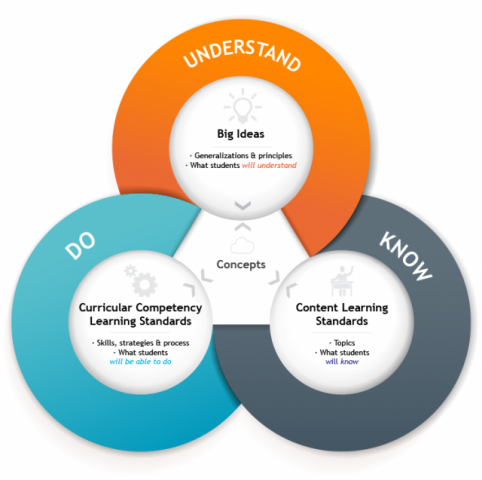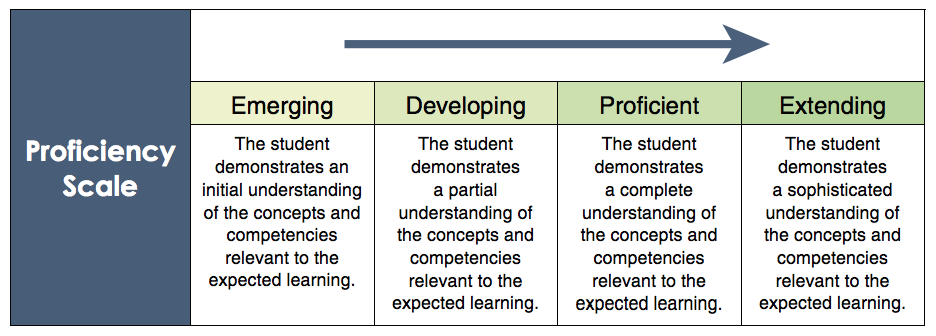Curriculum/Assessment
All areas of learning are based on a “Know-Do-Understand” model to support a concept-based competency-driven approach to learning.
Three elements, the Content (Know), Curricular Competencies (Do), and Big Ideas (Understand) all work together to support deeper learning.
Content (Know)
The content learning standards — the “Know” of the know-do-understand model of learning — detail the essential topics and knowledge at each grade level.
Curricular Competencies (Do)
The curricular competencies are the skills, strategies, and processes that students develop over time. They reflect the “do” in the know-do-understand model of learning. While curricular competencies are more subject-specific, they are connected to the core competencies.
Big Ideas (Understand)
The big ideas consist of generalizations and principles and the key concepts important in an area of learning. They reflect the “understand” component of the know-do-understand model of

British Columbia has a redesigned curriculum which means that we are also redesigning how we assess and report on student progress. According to the guidelines from the Ministry of Education, effective communication between home and school is central to student success. We will continue to communicate about student progress on an ongoing basis throughout the year. You will begin to notice some changes in format and language. There will be many opportunities to become familiar with these shifts.
For example, School District approved Proficiency Scales will be used, along with other tools, to give specific, constructive feedback to students and help Teachers move learning forward.

For more information about British Columbia’s curriculum, please check out the Ministry of Education’s website here.
Please find below a copy of our Term 1 Overview.
TERM 1
Language Arts
- Personalized Land Acknowledgements
- I Am From Poems
- Non-Fiction Reading Strategies (What in the World)
- Fiction Reading Strategies (Independent Novel Study)
- Research/Summarizing/Paraphrasing Skills
- Oral Presentation Skills
- Basic Grammar
- Writers Workshop (Different Styles of Writing)
French
- Communities where French is spoken across Canada.
- Letter patterns.
- High frequency vocabulary and sentence structures.
Math
- Multiplication and division facts to 100 (extending computational fluency).
- Operations with decimals (addition, subtractions, multiplication, division, order of operations).
- Relationships between decimals, fractions, ratios, and percents.
- Financial literacy-financial percentage.
- Operations with integers (addition, subtraction, multiplication, division, and order of operations).
Science
- Scientific Process
- Mixtures
- Separated using a difference in component properties
- Local first people’s knowledge of separation and extraction methods
- Heterogeneous mixtures
- Elements, compounds, and pure substances.
- Crystalline structure of solids.
- Chemical changes.
- Emulsification.
- Climate change and sustainability.
Social Studies
- Rights and responsibilities.
- Charter of Human Rights and Freedoms.
- Different systems of government.
- Roles of individuals, government organizations, and NGO’s.
- Election process and mock vote.
- Debates
Physical and Health Education
- Fundamental movement skills, concepts, and strategies.
- Ways to monitor and adjust physical exertion levels.
- FITT and SAID Principles
- Beep Test and cardiovascular fitness.
- Consequences of bullying, stereotyping, and discrimination.
Career
- Technology in learning and working.
- Problem-solving and decision-making strategies.
- Leadership
- Goal Setting
- Self-Assessment
- Project management skills.
- Local and global needs and opportunities.
Art
- Elements of art and principles of design.
- Image development strategies.
- How to use a variety of art forms and mediums.
- Processes, materials, movements, technologies, tools, strategies, and techniques to support creative works.
- Personal and collective responsibility associated with creating, experiencing, or presenting in a safe learning environment.
Applied Design Skills and Technology
- Year Long Research Study with SFU (Information will be sent home early in September along with the parent and student permission forms. Please reach out if you have any questions. This will be an exciting project for students to participate in).
- Digital literacy (internet safety, digital self-image, citizenship, relationships, and communication; legal and ethical considerations, including creative credit; copyright; cyberbullying; methods for personal media management; search techniques and criteria for evaluating search results; and strategies to identify personal learning networks).
- Drafting (digital and non-digital) technologies and techniques.
- Entrepreneurship and marketing (designing and making a product, branding, marketing, and financial budgeting and record keeping).
- Computers and communication devices (internet/personal communication devices, program uses, potential issues, and troubleshooting).
Music (Ms. Heard)
TERM 2
Language Arts
- Non-Fiction Reading Strategies (What in the World)
- Fiction Reading Strategies (Independent Novel Study, Whole Class Novel Study)
- Research/Summarizing/Paraphrasing Skills
- Oral Presentation Skills
- Basic Grammar
- Figurative language and literary elements, techniques, and devices.
- Writers Workshop (Different Styles of Writing)
- Narrative and Comic Writing
- Poetry
- Speeches
French
- Letter phonemes and letter patterns.
- Numbers, dates, and time.
- Masculine and feminine forms of words.
- Singular and plural forms of words.
- High frequency vocabulary, questions, and sentence structures for communicating meaning.
- Verb conjugation.
- Subjects and pronouns.
- Family Traditions Oral Presentation
Math
- Relationships between decimals, fractions, ratios, and percents.
- Factors and Multiples-greatest common factor and least common multiple
- Improper fractions and mixed numbers, ratios and percents.
- Relationships between decimals, fractions, ratios, and percents.
- Multiplication and division of decimals.
- Whole number percents and percentage discounts.
- Financial literacy-financial percentage calculations, sales tax, tips, discount, and sale price
- Referents and relationships between units (e.g., mm, cm, m, mg, g, kg, ml, L, etc)
- Perimeter, area and volume of complex shapes.
Science
- Climate change and how it affects the interconnectedness of plants and animals, and their local environment.
- Climate over geological time and the recent impacts of humans and the need for more sustainable practices.
- Ways of generating electricity including the use of wind, water, coal, geothermal, and solar energy and the different environmental impacts of each.
- Electromagnetism and how:
- the electromagnetic force is responsible for both electricity and magnetism
- moving or changing a magnetic field relative to a wire produces electric current (e.g., electricity generation by a turbine)
- an electric current passing through a wire produces a magnetic field (e.g., constructing a simple electromagnet using a wire, iron nail and battery)
Social Studies
- Global poverty, inequality, and the treatment of minority populations, and the historical displacement of Black communities in Canada.
- Modern Canadian society compared with past periods, and the impact of systemic discrimination and overt racism.
- How geographic challenges influence societies.
- Benefits and challenges of urbanization (land usage and environmental issues)
Physical and Health Education
- Fundamental movement skills, concepts, and strategies.
- Beep Test and cardiovascular fitness.
- Body systems, physical, emotional, and social changes that occur during puberty and adolescence.
- Wellness, hygiene, and balanced diets.
- 8 dimensions and 4 pillars of wellness.
- Hygiene practices.
- Factors that influence food choices.
- Signs and symptoms of stress, anxiety and depression.
- Self-care and the development of a self-care toolkit.
- Influences of physical, emotional, and social changes on identities and relationships.
- Sources of health information.
- Practices that reduce the risk of contracting sexually transmitted infections and life-threatening communicable diseases.
- Strategies to protect themselves and others from potential abuse, exploitation, and harm in a variety of settings
- Basic principles for responding to emergencies.
Career
- Goal Setting
- Project Management Skills
- Metacognitive Tools and Motivational Strategies
- Problem-solving and Decision-making Strategies
- Self-Assessment and Reflection
- Local and global needs and opportunities.
- Values and Stakeholder Perspectives
- Leadership Skills
Art
- Communicating complex ideas through symbols, colors, and elements, confidently taking creative risks to express deep personal feelings and experiences.
- Using symbolism and metaphors to create Surrealist works of art that invite viewers to uncover hidden meanings.
- Developing insightful artist statements that highlight major themes and encourage meaningful engagement and reflection.
- Strategies for producing work that is both thought-provoking and visually compelling.
Applied Design Skills and Technology
- Year Long Research Study with SFU
- ADST design process which includes empathizing with users to prototyping, testing, and sharing their product and design solutions.
- Climate Change and designing sustainable infrastructure for their community.
- Technical drawing and manual drafting techniques
- Microbits to explore computational thinking, including algorithms, input/output, sensors, and programming concepts such as iteration, randomization, selection, and variables.
Music (Ms. Heard)

